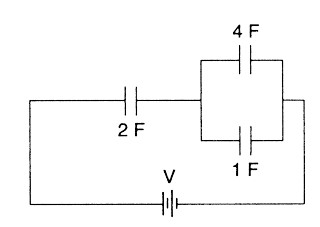QUESTIONS (a) AND (b) ARE BASED ON THE CIRCUIT SHOWN BELOW:

Question(a)
What is the maximum charge stored in the 2-farad capacitor?
(A) 4 C
(B) 16 C
(C) 10 C
(D) 8 C
▶️Answer/Explanation
Ans:(B)
Each capacitor receives the full 8 V from the battery because the capacitors are in series:
C = Q / V
2 F = Q /8 V
Q = 16 C
Question(b)
What is the maximum energy stored in the 8-farad capacitor?
(A) 64 J
(B) 256 J
(C) 32 J
(D) 128 J
▶️Answer/Explanation
Ans:(B)
\(1/2CV^{2}=1/2(8)(8)^{2}=256J\)
Question

What is the equivalent capacitance of the circuit shown above?
(A) 7/10 F
(B) 10/7 F
(C) 7 F
(D) 14/5 F
▶️Answer/Explanation
Ans:(B)
The capacitors with 4 F and 1 F are in parallel. Therefore, they are equivalent to one 5 F capacitor. This 5 F and the 2 F are in series:
1/5 + 1/2 = 7/10
10/7 F
Question
Which is storing more energy, a 20-microfarad capacitor charged up by a 6-volt source or a 10-microfarad capacitor charged up by a 12-volt source?
(A) They both store the same amount of energy.
(B) Neither is storing energy.
(C) The 20-microfarad capacitor is storing more energy.
(D) The 10-microfarad capacitor is storing more energy.
▶️Answer/Explanation
Ans:(D)
Compare \(1/2CV^{2}\) for each capacitor:
\(\frac{1}{2}(20)(6)^{2}\)= 360 microjoules
\(\frac{1}{2}(10)(12)^{2}\)= 720 microjoules
Question
The voltage between the plates of a fully charged parallel plate capacitor will
(A) be constant throughout
(B) fall linearly as you move from the positive plate to the negative plate
(C) fall quadratically as you move from the positive plate to the negative plate
(D) fall exponentially as you move from the positive plate to the negative plate
▶️Answer/Explanation
Ans:(B)
The constant electric field implies a linear fall in voltage as you move from the positive plate to the negative plate.
